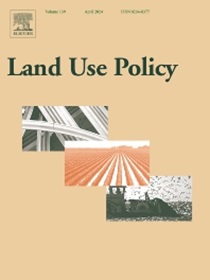Assessing the impact of urbanization and forest aging on carbon absorption in the Seoul metropolitan area of South Korea
IF 6
1区 社会学
Q1 ENVIRONMENTAL STUDIES
引用次数: 0
Abstract
In response to the escalating climate crisis, this study examined the dynamics of carbon absorption in the Seoul metropolitan area, focusing on the effects of urbanization and forest aging. Urban areas face increasing challenges due to climate change, necessitating a deeper understanding of how land-use changes and natural forest aging impact carbon sequestration. We assessed the spatial distribution and carbon absorption capacity of forests by categorizing the regions into urban centers, clusters, and non-urban areas. Using data from the Korea Forest Service and the National Forest Research Institute of Korea, we analyzed carbon absorption in 2013 and 2022, revealing significant shifts driven primarily by land use changes and forest aging. The results showed that urbanization led to a notable reduction in carbon absorption, with new city developments and unplanned expansions converting carbon-rich natural areas into artificial landscapes. Aging forests exhibit a decline in carbon sequestration, highlighting the need for sustainable forest management practices. This study highlighted the importance of tailoring city-specific strategies to enhance carbon absorption. This provides insights for policymakers to balance development with conservation efforts, ultimately contributing to more effective climate change mitigation in urban regions.
韩国首都圈城市化和森林老化对碳吸收的影响评估
为了应对不断升级的气候危机,本研究考察了首尔大都市地区的碳吸收动态,重点关注城市化和森林老化的影响。由于气候变化,城市地区面临越来越多的挑战,需要更深入地了解土地利用变化和天然林老化如何影响碳封存。通过城市中心区、城市群区和非城市区对森林的空间分布和碳吸收能力进行了评价。利用韩国林业局和韩国国家森林研究所的数据,我们分析了2013年和2022年的碳吸收,揭示了主要由土地利用变化和森林老化驱动的重大变化。结果表明,城市化导致碳吸收显著减少,新城市的开发和无计划的扩张将富含碳的自然区域转化为人工景观。老化的森林碳固存能力下降,突出表明需要采取可持续的森林管理措施。这项研究强调了制定城市特定战略以提高碳吸收的重要性。这为政策制定者平衡发展与保护工作提供了见解,最终有助于在城市地区更有效地减缓气候变化。
本文章由计算机程序翻译,如有差异,请以英文原文为准。
求助全文
约1分钟内获得全文
求助全文
来源期刊

Land Use Policy
ENVIRONMENTAL STUDIES-
CiteScore
13.70
自引率
8.50%
发文量
553
期刊介绍:
Land Use Policy is an international and interdisciplinary journal concerned with the social, economic, political, legal, physical and planning aspects of urban and rural land use.
Land Use Policy examines issues in geography, agriculture, forestry, irrigation, environmental conservation, housing, urban development and transport in both developed and developing countries through major refereed articles and shorter viewpoint pieces.
 求助内容:
求助内容: 应助结果提醒方式:
应助结果提醒方式:


